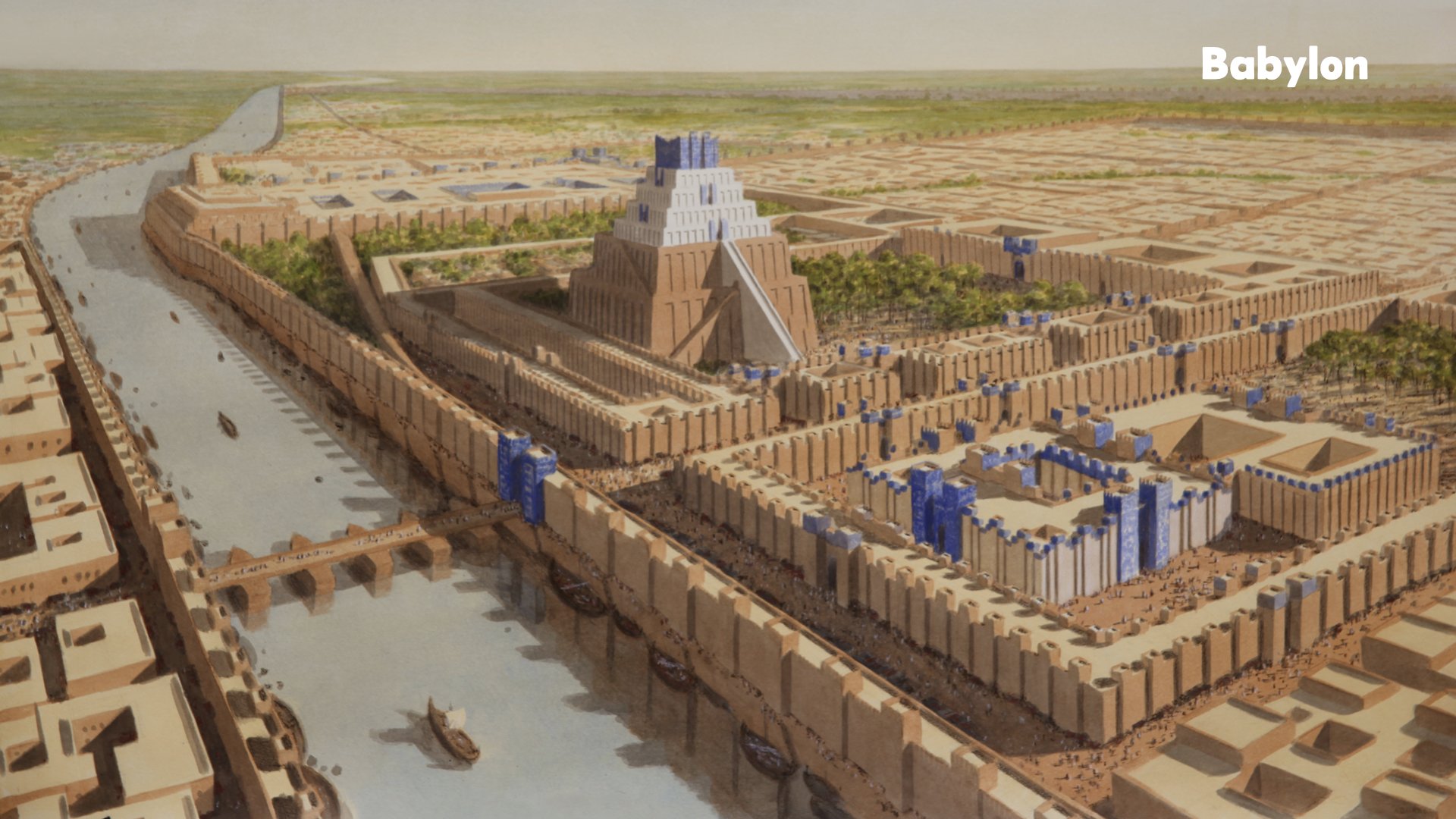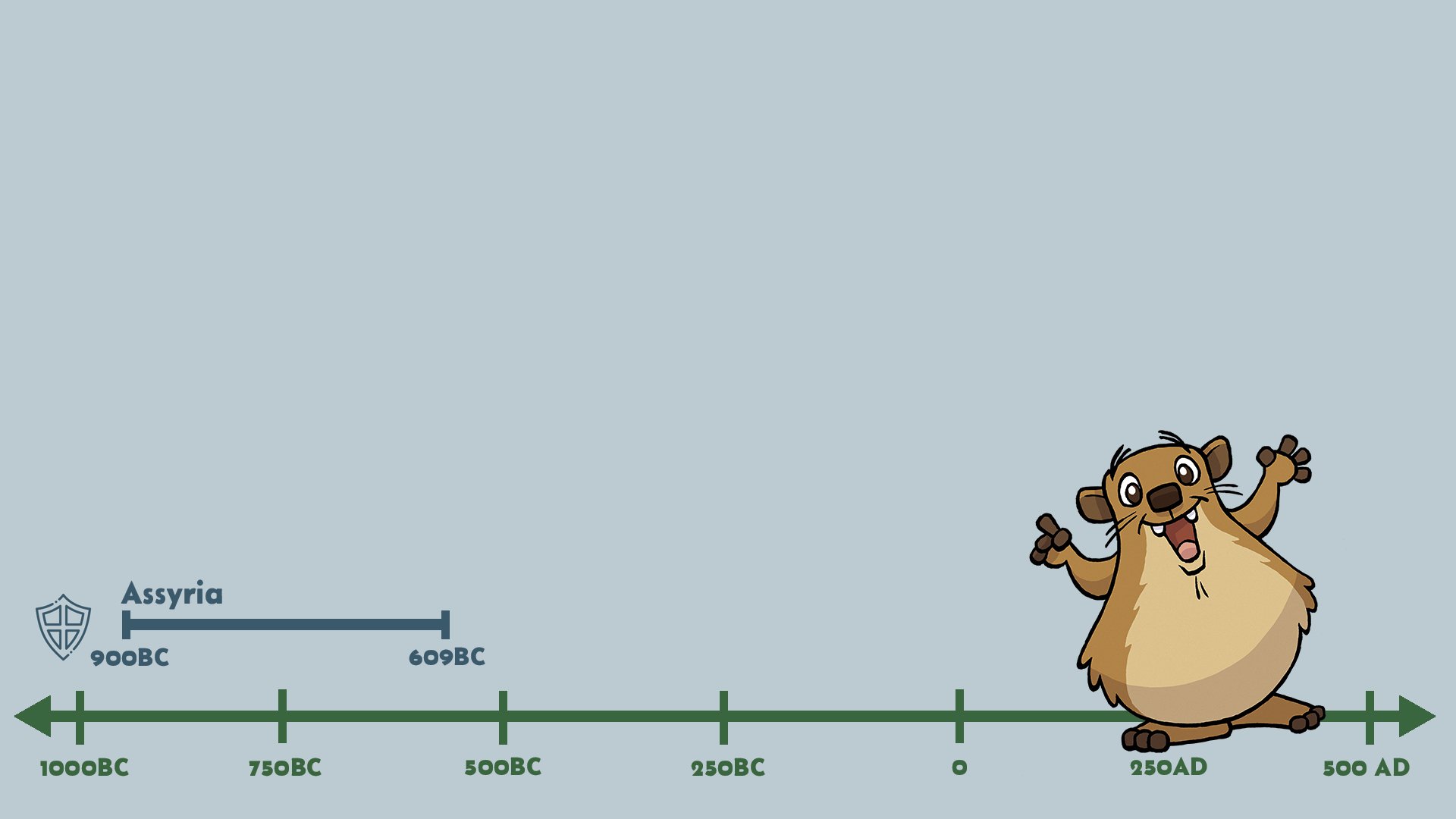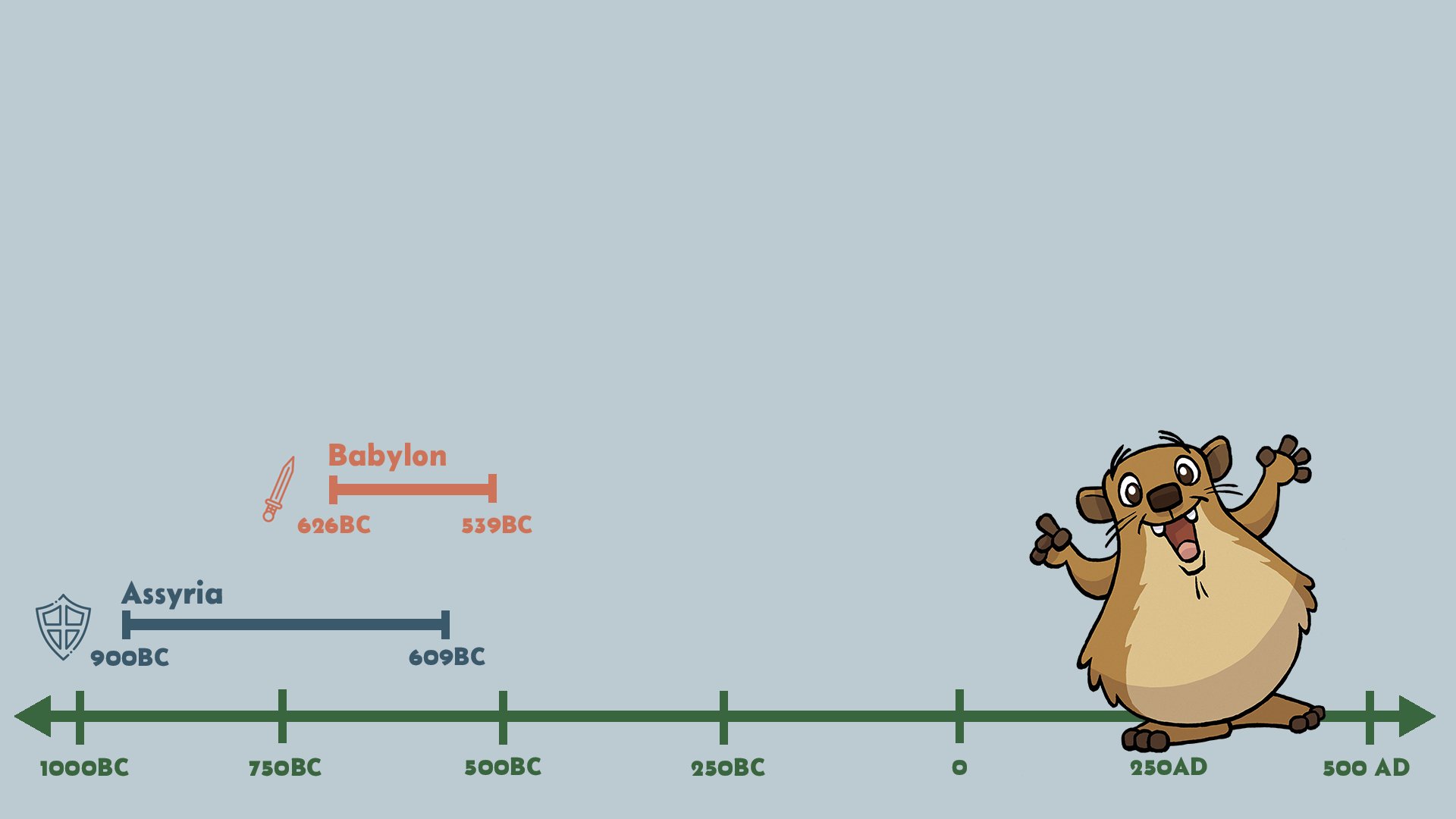LESSON INFORMATION
Unit Essential Questions:
What is the historical context of the world at the time of the kings and prophets?
What were the Empires that impacted the Biblical story?
How did the empires of the world impact God’s people?
Lesson Essential Questions:
Who were the Babylonians?
Bible Text:
None
Contextual Lenses:
Learning Goals:
Learners will be able to reflect on who the Babylonians were through the historical, cultural, geographical, and linguistic contextual lenses.
Common Core ELA:
CCSS.ELA-Literacy.RI.4.-Refer to details and examples in a text when explaining what the text says explicitly and when drawing inferences from the text.
CCSS.ELA-Literacy.RI.4.4-Determine the meaning of general academic and domain-specific words or phrases in a text relevant to a grade 4 topic or subject area.
CCSS.ELA-Literacy.RI.4.9-Integrate information from two texts on the same topic in order to write or speak about the subject knowledgeably.
CCSS.ELA-Literacy.SL.4.2-Paraphrase portions of a text read aloud or information presented in diverse media and formats, including visually, quantitatively, and orally.
Teaching Points:
The Babylonian Empire was a powerful empire that conquered the Southern Kingdom of Judah.
King Nebuchadnezzar took the people of Judah to Babylon and they lived in Babylon for 70 years.
The Babylonian Empire was conquered by the Persian Kingdom.
LESSON PREPARATION
What you should prepare . . .
-Set Up the Slides: Download and get the presentation slides ready to show.
-Prep the Posters: Print and laminate the posters for each station so they’re ready to use.
-Grab Supplies: Make sure you have crayons or markers for Stations 2 and 4. For Station 3, have a piece of clay for each learner for the cuneiform activity.
-Passports and Pencils: Have the students grab their passports and a pencil to use during the activity.
What you should know . . .
Empires around the world had many different historical eras and rulers. They were led by powerful kings, and many of them began as small kingdoms that took hundreds of years to grow into mighty empires.
Figuring out when these empires began and ended isn’t always easy. Some timelines are clearer because these empires were conquered in famous battles. However, their influence is harder to measure. These empires shaped the world in lasting ways and inspired those that came after them.
The capitals of these empires often changed over time, but in this study, we’ll focus on the time periods, capitals, and kings that connect to stories in the Bible. This unit will help you better understand the world of kings and prophets of the Bible and the history that surrounded them. Let’s dive in and start exploring!
LESSON INTRODUCTION
Get Ready to Travel Back in Time!
Today, we’re going on an exciting journey to explore the Babylonian Empire! (Slide 1: Babylon) Do you have your passports ready?
(Slide 2: Kingdoms Graphic) The Babylonian Empire is the second of five empires we’ll visit on our adventure. The others are Assyria, Persia, Greece, and Rome. Each of these empires played an important role in the Bible story, and together, they help us understand the world of the kings and prophets.
As we learn about these empires, we’ll add them to a timeline. (Slide 3: Timeline) This timeline will be the foundation for our study about the Kings and Prophets in the Bible.
To explore the Assyrian Empire, we’re going to look through four context lenses:
History
Geography
Linguistic
Culture
You’ll be split into four groups, and each group will visit a different station to learn about one of these lenses.
Are you ready to begin this adventure? Grab your passports, and let’s travel back to the time of the Babylonian Empire! (Slide 4: Babylonian Empire Slide)
ENGAGING WITH CONTEXT
Activity: Exploring the Babylonian Empire
Setup:
Divide learners into four groups and assign each group to a station. Each station will focus on a different aspect of the Babylonian Empire through a lens of context. Learners will use their passports to record what they discover. Set a timer for 5 minutes. When time is up, groups rotate to the next station.
Station 1: History (5 minutes)
Let’s discover the story of the Babylonian Empire!
Read Together: Start by reading the information provided about the Babylonian Empire.
Timeline Activity:
Open your passport to the timeline section.
Mark when the Babylonian Empire began and ended.
Draw a line connecting these dates to show how long the empire lasted.
Word Puzzle:
Use the clues in your passport to solve the crossword puzzle. Work as a team to find the correct answers based on the reading.
The Babylonian Empire
The Neo-Babylonian era was from 626-539 BC, a time when the Babylonian Empire became very powerful. It was ruled by famous kings, who built amazing things like the Hanging Gardens of Babylon, one of the Seven Wonders of the Ancient World. During this time, Babylon became a center of art, science, and learning.
The Babylonians were skilled in math and astronomy, and they used a calendar based on the moon, which divided each month into 30 days and a year into 12 months. Their priests studied the moon, planets, and stars very carefully in order to predict the future.
The city of Babylon itself was very impressive, with huge walls and beautiful palaces. The wall around the city was 56 miles long. That means it would take about an hour to drive around it in a car. In the center of the city was a ziggurat temple that resembled a pyramid. It was almost 300 feet tall, the same size as the Statue of Liberty!
Babylonians produced a variety of crops. One of the crops they grew was pistachios. They worshipped multiple gods and goddesses, but their chief god was Marduk.
The Babylonians conquered the Southern Kingdom of Israel in 597 BC, under the rule of King Nebuchadnezzar. They took the prominent citizens, including Daniel and his friends, to Babylon where they lived for seventy years. In 587 BC, the Babylonians destroyed the temple in Jerusalem. The Babylonian Empire fell to the Persians in 539 BC, and the Jews were allowed to return their land.
Puzzle Questions and Answers:
Down:
The Babylonian Empire fell to the ____________.
One of the crops grown by the Babylonians were ____________.
5. The Israelites lived in Babylon for ____________ years.
7. ___________ was a prominent citizen of Israel taken to Babylon.
Across:
The chief God of Babylon was ____________.
The wall around Babylon was 56 ____________ long.
6. Babylon is famous for its’ hanging ____________.
8. The Babylonian calendar was based off of the ____________.
Station 2: Geography (5 minutes)
Let’s explore the map! The Babylonian Empire was in Southern Mesopotamia, which we now call Iraq. The city of Babylon was built on the Euphrates River.
Find Your Home and Iraq:
Look at a globe or map. Can you find where you live?
Now, find Iraq! That’s where the Babylonian Empire was located.
Color the Babylonian Empire:
On the map in your passport, color in the area where the Babylonian Empire once ruled. Use bright colors to show how big it was!
Station 3: Linguistic (5 minutes)
Let’s learn about language! Babylonians and Assyrians both spoke a language called Akkadian. It was the same language, but Babylonian Akkadian sounded a little different from Assyrian Akkadian.
Practice Speaking Akkadian!
The Babylonian Akkadian word for “Hello” is šulmum (SHOOL-moom). If you want to say “Greetings to You,” you can say: šulmum ana kâšim (SHOOL-moom AH-nah KAH-sheem).Turn to the person next to you and say “Hello” or “Greetings to You” in Akkadian!
Take turns practicing until you both feel like experts in ancient Babylonian greetings.
2. Write in Cuneiform!
Akkadian was written using cuneiform, which means "wedge-shaped." These marks were pressed into clay tablets with sharp tools.
Use the tip of a pencil and clay provided to write your name in cuneiform, just like a Babylonian scribe.
If you need a reminder, look at the cuneiform alphabet from the last lesson to see how your name looks in wedges.
Station 4: Culture (5 minutes)
Let’s dig into the past through artifacts! Archaeologists are like detectives of history. They learn about ancient empires and the people who lived in them by studying special objects, called artifacts, that are buried in the ground. These artifacts tell us amazing stories about life long ago.
Read through the artifact posters together.
Pick an Artifact:
Choose one of the artifacts described in the reading.
Look closely at what makes it special and imagine what it was used for.
Draw It:
In your passport, draw a picture of the artifact you chose. Be creative and add lots of detail!Write One Cool Fact:
Write down one interesting thing you learned about the artifact.
Ishtar Gate: The Ishtar Gate was one of the most famous entrances into the inner city of Babylon, the capital of the Babylonian Empire. It was the eighth gate leading into the city and was made from strong mud bricks. This incredible gate was decorated with carved bulls and dragons, which were believed to protect the city from evil. To make it even more stunning, the bricks were glazed in bright, vibrant colors like blue, red, and yellow.
Code of Hammurabi: The Babylonian King Hammurabi is remembered for creating one of history’s first sets of written laws: the Code of Hammurabi. These laws were carved in cuneiform on a tall stone monument that stood seven feet, four inches high! The Code of Hammurabi was used to govern the Babylonian Empire and is famous for the idea of “an eye for an eye.” This means that punishments should match the crimes committed, aiming to create fairness and justice.
Babylon Head Sculpture: Sculptures from the Babylonian Empire give us clues about how the people looked and dressed! Both men and women wore tunics and draped themselves in shawls with tassels. They loved wearing their hair long and curly. Men grew long beards and curled them too, making them look fancy! For headwear, they often wore caps made of wool, felt, or leather.
EXPLORE THE STORY
(Slide 5: Timeline - Babylon)
Gather learners together and ask if they discovered the dates marking the Assyrian Empire. Bring the timeline up on a screen. Spend a few minutes discussing learner’s discoveries. Possible wondering questions/starter points:
What was the most interesting thing you learned today?
If you could visit the Babylonian Empire, what would you want to see or do?
What surprised you the most about the Babylonians?
What connection did the Babylonian Empire have to the Bible?
RESPOND TO THE STORY
Passports Stamps:
When learners finish filling out the information in their passports, celebrate their achievement by adding the empire’s stamp inside! This stamp shows they’ve “explored” the Babylonian Empire and learned all about it. Great job, explorers!
Lesson Files Include:
Lesson PDF
Presentations Files (Keynote, Power Point, Google Slides)
Station Posters
Passport Printout
Passport Stamp Printout
Passport stamp sticker sheets coming soon!
Contact info@lovegodloveothers.com if you are interested in trying out this unit with your students!











